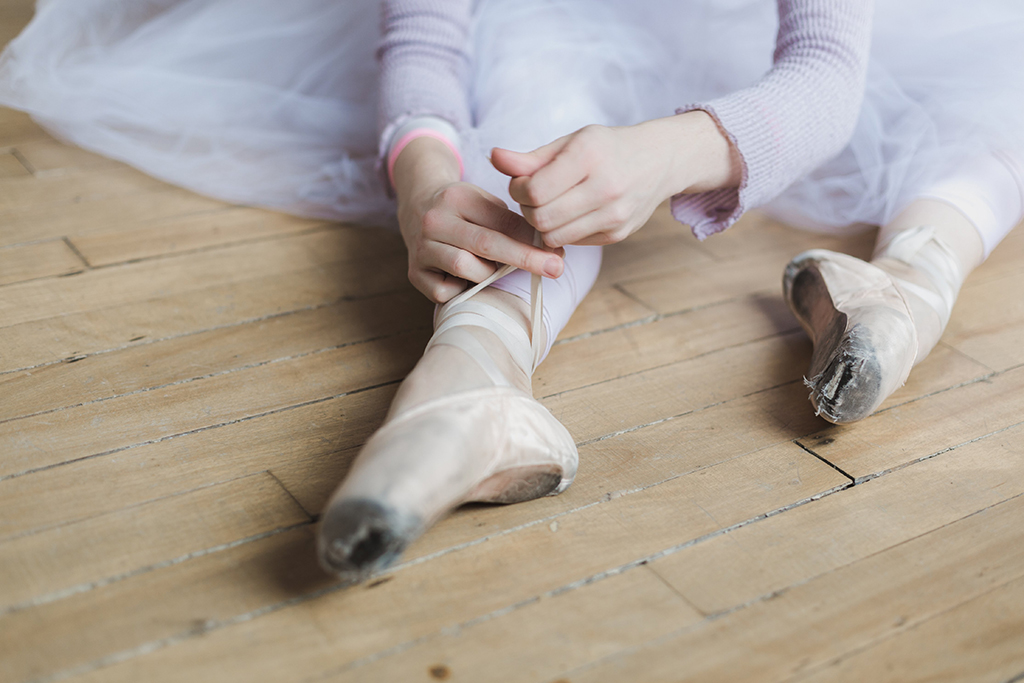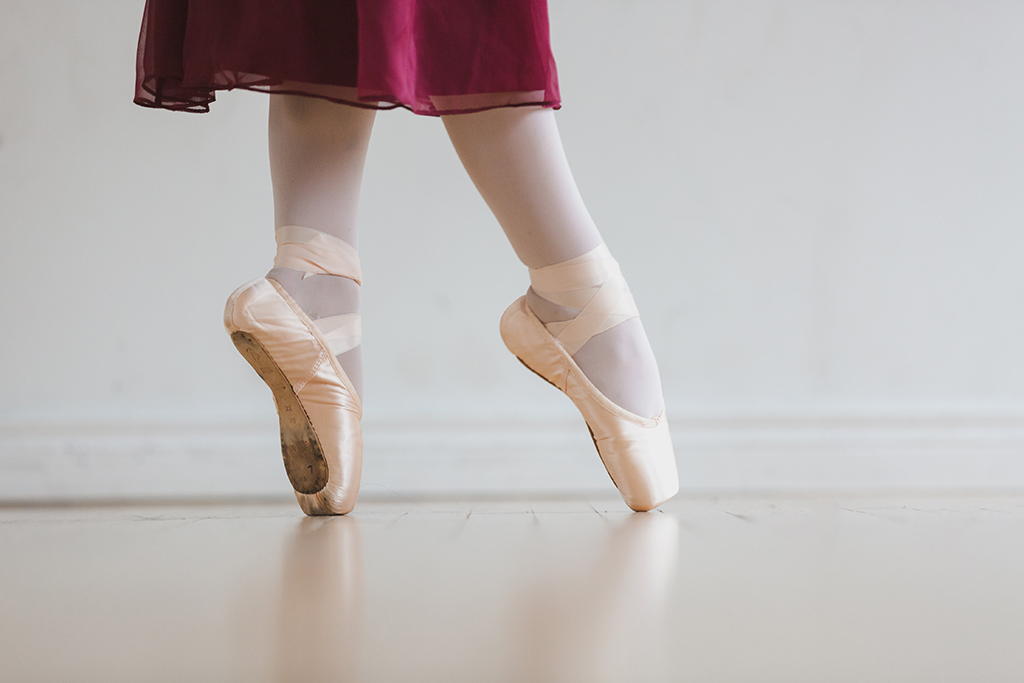When To Start En Pointe – Pointers From An Orthopedic Foot Surgeon

Dr. Warner Here –
Today, I am answering an important question that affects dancers of all ages: when should a dancer begin en pointe?
In the pursuit of the beauty and elegance that is ballet, most dancers wish to progress in their sport to the level of ‘en pointe.’ The en pointe position is notoriously difficult to achieve and is the possible source of many injuries. There is an ongoing debate in the dance medicine community regarding the age at which one should begin to explore this facet of the art.
En pointe is when the ankle is plantar flexed so much that the dorsal surface of the foot is in a direct line with the anterior edge of the tibia. In other words, the leg becomes a very straight and beautiful line from the hip to the tip of the toe. This requires an extreme range of motion of the ankle and foot joints along with required range of the hip and knee and significant strength, balance sense and reflexive athletic abilities.
Ballet applies very high loads in a repetitive fashion to all of the muscles, ligaments and other connective tissues of the young body. In the supraphysiologic postures required of this sport, these high loads and stresses applied to the body often result in injury. En pointe is simply the most extreme of the combination of excessive positioning and large strains.
Preventing Ballet Injuries
Most dancers will sustain an injury during his or her career. En pointe is usually performed by females and more injuries occur in females. About 60-90% of dancers will have an injury. These effect the spine, hips, knees and ankle/foot complex. Most injuries to ballet dancers occur in the foot and ankle.
The best way to treat an injury is to prevent it. Obviously, dancers will not be able to prevent all injuries and this is not expected in any sport. En pointe is particularly stressful to the body and associated with many injuries and to prevent is paramount. When beginning en pointe, one is even more prone to injuries simply from lack of conditioning and familiarity with the position. As well, dancing in pointe shoes increases the forces placed on the foot by 12 times body weight. Therefore, there is hesitation amongst most dance professionals and those of us that treat dancers’ injuries and medical conditions to allow this supraphysiologic position to be attained too early in a career. However, to wait too long to dance en pointe might hurt a dancer’s chances to progress, grow, and achieve her goals. This is the conundrum I will address for you now.

Ages To Consider
At this time there is a lack of information that pertains to injuries among younger dancers. There is likewise a lack of evidence showing a direct causal relationship with en pointe and injuries; there is correlation; most studies show the preponderance of injuries happen in adolescence around the time en pointe is traditionally begun. In addition, there is no consensus as to the best way to gauge a dancer’s readiness to start en pointe. There are some accepted methods that are used, but these vary nationally and across the world. Usually, subjective judgement of the teacher/instructor is the only guide.
Chronological age is still the most accepted method for deciding the best time to begin en pointe. Other parameters that are considered are year of training, lower extremity strength, neuromuscular control, years of experience, skill acquisition and ankle/foot range of motion and flexibility.
Other Considerations
Generally, there are 8 commonly used screening methods to assess readiness to enter pre pointe and then en pointe:
- Age
- Years of dance experience
- Present injuries and past injuries
- Relevé alignment and stability
- Plié alignment and stability
- Tendu strength
- Activation of intrinsic foot muscles
- Upper body alignment and stability
Specific tests such as the Topple test, Airplane test and Sauté test have been thought to be very helpful in the analysis. Other physical measures used 1st, 2nd, 5th position with any compensations observed, relevé passé and grand plié (multiple positions).
However, age is absolutely the most common and trusted method to determine readiness for en pointe worldwide. Of schools surveyed, most identified the age of 12 as the most appropriate; but the range of ages was 9-13.
Age is concerning both because of growth plates and the changes that happen during puberty. Puberty occurs at variable ages but generally is in the early teens. This is moving up earlier and earlier in Western countries. During puberty there are massive changes in the body, brain, chemical balance and interconnectedness of all of this. This change period puts the body at risk of injury. Growth plates are less of a concern, but there are case reports of premature closure of growth plates from en pointe. Bear in mind, the foot growth plates really don’t close until the age of 18; no one advocates waiting until then to start en pointe.

During the time of puberty, there are growth spurts. So, in addition to the cognitive and psychosocial skills that are developed during puberty, growth adaptation is also happening. Growth is very much associated with injury. There is a decreased motor ability and balance ability during adolescence from growth and puberty. The body’s sensorimotor and reflexive systems adjust to the changes. For instance, it is thought that muscles may need to produce 30% more force during a growth spurt to provide the same amount of acceleration of a given area prior to a growth spurt. There is a period of time then when the dance must adjust and adapt to the new reality of her body; skills must be reacquired in the cognitive and physical realm. En pointe is already difficult and risky and should begin after proper adaptation has occurred.
One of the criteria often used to assess readiness to start en point is not just age, but years of training; along with this is the skill acquisition and technical abilities achieved. All of this becomes less valid once puberty starts as there are so many changes. Thus, it may be best to allow puberty to begin and the dancer to adapt to the changes in the mind and body prior to adding the stress of en pointe. Also, years of training does not necessarily always translate to ‘quality years’ of training.
Mental maturity and physical capacity are mandatory to start en pointe. Most do not possess both in amounts needed until around the age of 12. That being said, the brain does not fully develop until around age 25. A dancer must have adequate range of motion to achieve this difficult position. Also, there must be enough strength to achieve postural control and balance. There must be a mastery of technique and movement with good proprioception and alignment. Beside age, all other assessments to date are very subjective and prone to error. Many teachers and instructors will not be able to recognize subtle compensations that happen for dancers and might advance a dancer too soon.
A Surgeon’s Opinion
Based on the above discussion, it seems that until such time as a strong, valid and objective measure of readiness for en pointe is available then age is the best measure. The age most commonly agreed upon is 12. In my opinion, if a dancer is extremely talented and mentally mature perhaps she could start en pointe at 11.
Meredith Warner, MD MBA
Board-certified Orthopedic Surgeon, Fellowship-trained in Foot and Ankle surgery
Relief & Recovery at Warner Orthopedics
At Warner Orthopedics & Wellness, we can help you to overcome pain and injury so that you don’t miss a single beat. Our specialists will work with you to find the right method of treatment, and we promise to always seek non-surgical methods as your first option.
If you are looking for high-level care from certified, caring physicians, give us a call today at (225) 754-8888 or schedule an appointment at our brand-new clinic!





